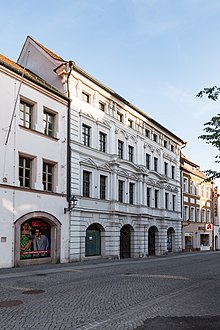Fortschauer armature factory
The Fortschau armature factory was located in what is now the Fortschau part of Kemnath . From 1689 to 1801 it was the only major manufacturing facility for handguns in Bavaria .
history
The establishment of the factory was preceded in 1689 by the acquisition of the Hirschberg-Schlösschen in Fortschau from the Sensenschmidt's heirs to Kemnath and Eschenbach by Elector Maximilian II Emanuel . The mines on Fichtelberg , where good iron was produced, were located nearby . The court musician (!) Thomas Macolini had made the suggestion to use the Fichtelberg mining and smelting works, which had fallen to the state, as a "fittings factory" and was successful with it; he was appointed to the electoral council and mountain bishop and also received the office of district judge of Waldeck-Kemnath. On April 8, 1690 he was raised to the nobility and called himself from then on "Hofkammerrat, Truchseß and Bergobrist Thomas Macolini von Siessenfeld". In 1696 Thomas Macculin von Süssenfeld acquired the Kaibitz Castle and settled there until his death. Although the factory was founded by an amateur, it lasted until 1801.
Under the direction of a “fittings inspector” and a “master inspector” , around 30 masters ( gunsmiths , shifter , pipe smiths, drill masters, etc.) and their journeymen worked here after the factory was set up . Suhl had recruited them. The focus of production was on the manufacture of infantry rifles , especially flintlock rifles with bayonets , also known as bayonet rifles or fusilier rifles. Also under the successors Karl Albert and Maximilian III. Joseph kept the valve factory in operation. The workshops were spread over Fichtelberg, Fortschau, Unterlind, Mitterlind, Ebnath and Kaibitz. The construction of the workshops and accommodations amounted to 15,187 fl . The production of two hundred and fifty to three hundred pipes per week was possible. After the barrel was completed and a second time after a rifle was assembled, the fire was fired with a double charge.
Under Elector Karl Theodor , General Graf von Rumford developed the idea of relocating the Fortschauer armatures to the roundabout of the gate for the new Stachus in Munich . The production rooms were to be set up on the ground floor and apartments for the employees on the floors above. The background was the planned reinforcement of the Bavarian army to 30,000 men and the resulting large need for weapons; In addition, the Fortschauer plant was structurally poor at the time and could not deliver the planned quantities of weapons. On October 31, 1792, the electoral court war council received the "highest resolution that the highest of the same had been moved to have a Frabrique in Dero, the royal seat of Munich, in the two outbuildings or rondels at the new Carls-Thor" ". Those who did not want to leave their workplace in Fortschau should continue to be busy with the production of barrels, locks, fittings, trimmings, etc. in Fortschau, but should deliver them to Munich. Lieutenant Reichenbach, who was dispatched to Fortschau on August 20, 1793, was unsuccessful because no one was willing to leave his home country. Under the leadership of Kemnath citizen and gunsmith Thomas Kugler , a declaration was drawn up in which the Fortschau workers insisted on continuing their work in Fortschau. The relocation plan failed, but the fittings were thoroughly renewed.
Under Elector Maximilian IV Josef , the generals pushed for the establishment of a larger plant and on March 7, 1801, they were successful. The mint building in Amberg was designated for the construction of the rifle factory and after 110 years the end of the Fortschauer factory. The former inspector Johann Friedrich Zigono was still allowed to produce rifles on a private basis in Fortschau or in the Waffenhammer in Grünberg . In 1823 the building of the abandoned valve factory was adapted for residential purposes. The Kemnath citizen Paul Strickner , whose father had worked as a stockpaker in Fortschau, bought the building and told the Kemnath city council on May 31, 1823 that he wanted to separate the rifle chamber into four parts so that four families could be accommodated here. Since the Royal Building Inspectorate did not bring up any " memories " against the plan, the renovation was approved.
Products from the armature factory are exhibited today in the local history and handgun museum in Kemnath.
literature
- Dirk Götschmann: Upper Palatinate iron. Mining and iron industry in the 16th and 17th centuries. Edited by the Association of Friends and Sponsors of the Mining and Industry Museum in East Bavaria (= Volume 5 of the series of publications by the Mining and Industry Museum in East Bavaria), Theuern 1985.
- Anton Reger: From the history of the city of Kemnath. Homeland book (edited by the city of Kemnath). Pp. 243-246. Verlag Laßleben , Kallmünz 1981, ISBN 3-7847-1134-0 .
Web links
- Dirk Götschmann : The fittings factory Fortschau (1689-1801). History of an electoral company in the Upper Palatinate. In: Heimatforschung-Regensburg. August 26, 2016. Retrieved August 29, 2019 .
Coordinates: 49 ° 51 ′ 47.6 " N , 11 ° 53 ′ 20.58" E
